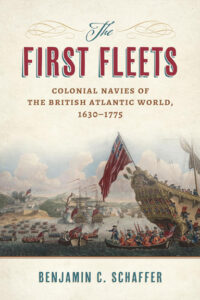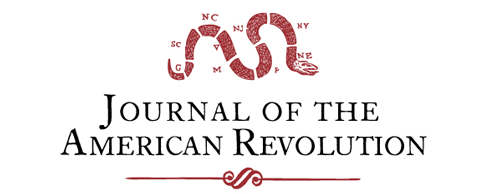BOOK REVIEW: The First Fleets: Colonial Navies of the British Atlantic World, 1630-1775 by Benjamin C. Schaffer (University of Alabama Press, 2025) $34.95, paperback
The United States Navy honors October 13, 1775 as its birthday in keeping with a resolution passed by the Second Continental Congress to acquire two vessels “for a cruize eastward, for intercepting such transports as may be laden with warlike stores and other supplies for our enemies, and for other purposes as the Congress shall direct.” While that marked the creation of the Continental Navy, rebelling colonies had already established modest seagoing forces and George Washington was already using continental funds to create a small fleet under the auspices of the Continental Army.
 As Britain’s rebelling colonies mobilized to challenge its authority, one of the greatest challenges they faced was the Royal Navy’s relative command of the ocean. Most colonies had militia laws and traditions going back to their early establishment that they could turn to in order to create land forces capable of contesting the British Army. On the sea they were on shakier “ground,” if we can pardon the pun. Still, they were not creating naval power from whole cloth. Benjamin Schaffer’s new book The First Fleets: Colonial Navies of the British Atlantic World, 1630-1775, examines colonial naval traditions and capabilities over the century and a half that preceded the Revolutionary War. It is an often overlooked period in American maritime history and, as Schaffer argues, an important one in understanding both the growing tensions between Britain and its American colonies and the not-so-surprising facility with which thirteen rebelling colonies created their own forms of naval power.
As Britain’s rebelling colonies mobilized to challenge its authority, one of the greatest challenges they faced was the Royal Navy’s relative command of the ocean. Most colonies had militia laws and traditions going back to their early establishment that they could turn to in order to create land forces capable of contesting the British Army. On the sea they were on shakier “ground,” if we can pardon the pun. Still, they were not creating naval power from whole cloth. Benjamin Schaffer’s new book The First Fleets: Colonial Navies of the British Atlantic World, 1630-1775, examines colonial naval traditions and capabilities over the century and a half that preceded the Revolutionary War. It is an often overlooked period in American maritime history and, as Schaffer argues, an important one in understanding both the growing tensions between Britain and its American colonies and the not-so-surprising facility with which thirteen rebelling colonies created their own forms of naval power.
Schaffer finds a surprising degree of naval independence among Britain’s colonies during most of the period covered in his study. Individually, in times of crisis the colonies created naval power in response to the Royal Navy’s inadequate, uncoordinated, or even unhelpful presence—or lack thereof—along the Atlantic coast. By impressing, leasing, or building ships, provincial governments created small flotillas to act as guardships in key areas, undertake minor offensive operations against foreign adversaries (including indigenous nations), pursue privateers, or even cooperate with the Royal Navy in major campaigns. These provincial navies were not “navies” in any European sense. In their earliest guises and during much of their history, they were short-lived flotillas of large boats suited to coastal operations, but occasionally boasted a small sea-going ship such as a single-masted sloop or larger brig. Most were converted from civilian purposes. This reflected both the limited resources available to individual colonies and the narrower needs that provincial navies faced. Larger provincial ships were few and far between until the middle of the eighteenth century.
During most of the seventeenth and early eighteenth centuries, the Royal Navy was rarely present along the colonial coast. It lacked the bureaucratic depth and resources to maintain a significant fleet presence across the Atlantic. Indeed, in creating ad hoc navies on an as-needed basis, the colonies were following well-established British practices of self-help that London was in the process of replacing with the institutionalized means of creating, sustaining, and operating a navy. This later incarnation of the Royal Navy increased conflict with colonial populations over matters of control, authority, and impressment even as it reduced the need for colonial governments to finance their own navies. By the time of the French and Indian War, the colonies had largely stopped creating their own naval forces and relied almost entirely on the Royal Navy for maritime security, yet the growing presence of the Royal Navy along the coast increasingly made it an instrument of imperial control in North America, and a source of the growing conflict between Britain and its colonies.
The First Fleets offers the kind of foundational understanding that will long contribute to the study of British and American maritime history. More importantly, Schaffer adds new facets to our appreciation of Britain’s eighteenth century imperial crisis, the birth of the American Navy, and the beginning of the American Revolution.
PLEASE CONSIDER PURCHASING THIS BOOK FROM AMAZON IN PAPERBACK OR KINDLE.
(As an Amazon Associate, JAR earns from qualifying purchases. This helps toward providing our content free of charge.)





Recent Articles
The New Dominion: Virginia’s Bounty Land
This Week on Dispatches: Stuart Lillie on Henry Knox’s Artillery Train
Vanishing Ranks: Rawlings’ Rifle Regiment and the Struggle to Recruit for the Frontier
Recent Comments
"The New Dominion: Virginia’s..."
Excellent overview of the convoluted system for awarding bounty lands during and...
"Vanishing Ranks: Rawlings’ Rifle..."
Good work here. This being one of the harder units to research,...
"The Declaration of Independence:..."
I don't know whether or not it's true that John Hancock said,...